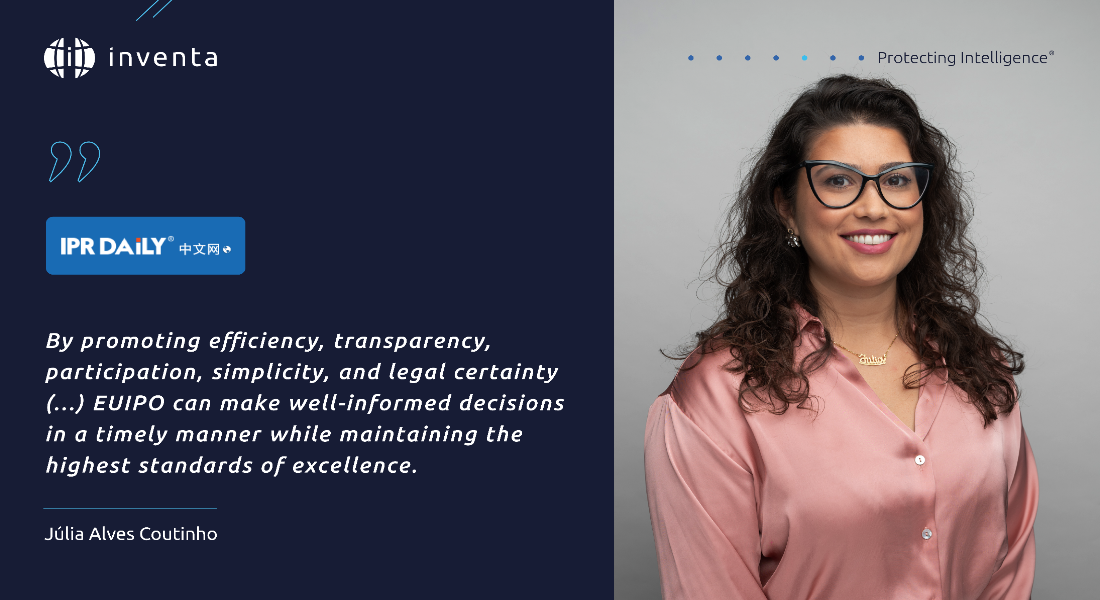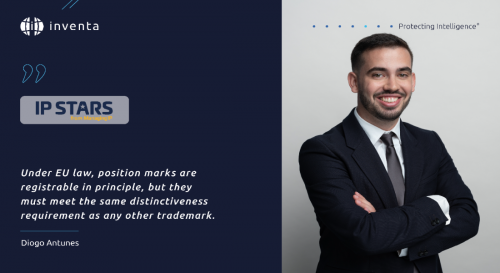
Principle of Procedural Economy Applied to the EUIPO's Decisions
One fundamental aim of every civil justice system is the efficiency, assuring that any administrative or judicial institution be capable of decide in a timely and cost-effective manner, without compromising the quality and legitimacy of the process, which is known by the principle of procedural economy or judicial economy.
This principle is particularly important in the context of the European Union, where multiple institutions, including the European Commission, the European Parliament, and the Council of the European Union, are involved in the decision-making process.
In this sense, this principle is applied in Intellectual Property legislation, appearing in the recitals of the Regulation (EU) 2017/1001 of the European Parliament and of the Council of 14 June 2017 on the European Union Trademark and in the recitals of the Council Regulation (EC) no. 6/2002 of 12 December 2001 on Community designs. Therefore, it is applied by the European Union Intellectual Property Office (EUIPO) in the decisions involving trademarks and designs, called by principle of economy of proceedings.
In the beginning of the EUIPO Guidelines on Trademark and Designs, it is said that “In the interests of efficiency and in order to prevent parties encountering different practices, the Office applies procedural rules consistently”.
In addition to the principle of procedural economy, the Office is also obliged to comply with other the general principles of the European Union law, such as adequate reasoning, right to be heard, equal treatment, legal certainty and sound administration.
Despite of that, the Office is not bound to respond to all the arguments raised by the parties, being sufficient that the Office sets out the facts and legal considerations of fundamental importance in the context of the decision. Therefore, this conduct does not necessarily infringe the duty to state reasons, as confirmed by several decisions of the General Court and of the Court of Justice. [1]
Moreover, the Office is not required to give express reasons for its assessment in respect of each and every piece of evidence submitted or arguments put forward, where it considers that evidence or arguments to be unimportant or irrelevant to the outcome of the dispute.[2]
Furthermore, and in compliance to the principle of economy of proceedings, the Office is not required to prove the accuracy of well-known fact[3] used as a basis for its reasoning and, therefore, it is not obliged to give examples of such practical experience; it is up to the party concerned to submit evidence to refute it.[4]
Trademarks
Several legal grounds, based on different earlier rights, may be alleged in either the same or multiple oppositions against the same European Union trademark application.
Following the filing of an opposition within the deadline and upon the payment of the official fee, the Opposition Division will first examine the admissibility of the opposition, to check if the invoked right(s) is(are) earlier and valid within the European Union. If the opponent relies the opposition on more than one right, it is sufficient that one of them is prior and valid in the EU for the opposition to be admitted, and it is not necessary for the opponent to remedy deficiencies in relation to rights that do not serve as a basis for the opposition.
Regarding the exam of the opposition itself, it is consolidated the understanding that the Office is under no obligation to examine all the earlier oppositions, rights and legal grounds invoked against the same European Union trademark application if one of them suffices to reject the EUTM application; nor is it obliged to choose the earlier right with the widest territorial scope so as to prevent the eventual conversion of the application in as many territories as possible, as confirmed by the Court of Justice in decisions of 2004 and 2006.[5]
Furthermore, in line with procedural economy rules, the Office may examine the likelihood of confusion without undertaking a comparison of goods and services if upon examining all the other relevant factors (...) any likelihood of confusion can be ruled out.
As said in the EUIPO’s Guidelines, the Office may choose what it regards as the ‘most effective’ opposition(s), earlier right(s) and legal ground(s) and which one to examine first considering the principle of procedural economy.
The EUIPO describes the ‘most effective’ opposition as the opposition that allows the Office to refuse the registration of the opposed EUTM application to the broadest possible extent and in the simplest manner. The ‘most effective’ earlier right is defined as the most similar (the closest) sign covering the broadest scope of goods and services and/or the right covering the most similar goods and services. And the ‘most effective’ legal ground is described as the opposition ground that presents the Office with the simplest manner of refusing the registration of the opposed EUTM application to the broadest possible extent.
If the opposition is based in one or more trademarks registered more than five years, the EUTM applicant may request proof of use of these previous registrations. However, if evidence of use has been requested by the applicant in relation to some of the earlier rights, the Office will normally first consider if the opposition can be fully upheld based on one or more earlier rights not subject to the requirement to prove use. In such a case, the EUTM application will be rejected without it being necessary to consider proof of use. Only if no such earlier right(s) is (are) available, will the Office consider those earlier rights for which proof of use was requested.
The EUIPO may also restrict the examination of the opposition on the part of the public that is most prone to confusion between the signs and the analysis should not extend to all parts, considering the following situations: a) likelihood of confusion is in a specific linguistic area – the Office’s analysis need not extend to the whole EU but may instead focus on that part; b) likelihood of confusion in general consumers or professional consumers – if the likelihood of confusion is to be confirmed on the part of the general public, there is no need to examine it based on the perception of professionals, and vice versa.
Furthermore, in line with procedural economy rules, the Office may examine the likelihood of confusion without undertaking a comparison of goods and services if upon examining all the other relevant factors (such as the degree of similarity of the signs, the distinctiveness of the earlier mark, degree of attention of the relevant public and the principle of interdependence) any likelihood of confusion can be ruled out.
Finally, the Office may decide not to examine the opponent’s claim and evidence of enhanced distinctiveness of the earlier mark(s), if based on the other relevant factors a likelihood of confusion can be established based on the inherent distinctiveness of the marks.
Where appropriate, the Office may decide to proceed based on the assumption that the earlier marks enjoy enhanced distinctiveness. The examination of the claim and evidence of enhanced distinctiveness of the earlier marks may be dispensed with if upon examining all the other relevant factors any likelihood of confusion can be ruled out.
Regarding cancellation proceedings, after the registration of a trademark, if the same EUTM is subject to both revocation and invalidity proceedings, the Office has the power of discretion to decide in each case, taking into account the principles of economy of proceedings and administrative efficiency, whether one of the proceedings has to be suspended until the other has terminated, or in which order the proceedings should be decided.
If it is first decided that the EUTM is totally invalid (or partially, but for all the goods/services against which the revocation is directed), and once this decision becomes final, the parallel revocation proceedings will automatically be closed, as they no longer have any object.
However, considering the different effects of revocation (ex nunc) and of a declaration of invalidity (ex tunc), when it is first decided that the EUTM should be totally revoked (or partially, but for all the goods/services against which the invalidity is directed), the Office will inform the applicant of this decision when it becomes final and will invite it to submit its observations on the closure of the invalidity proceedings. If the applicant demonstrates sufficient legal interest in obtaining a declaratory invalidity decision, the proceedings will continue.
By promoting efficiency, transparency, participation, simplicity, and legal certainty, this principle seeks to ensure that the EUIPO can make well-informed decisions in a timely manner while maintaining the highest standards of excellence.
Designs
The same applies to the exam of the admissibility of an application for a declaration of invalidity of a Community design.
According to the principle of procedural economy, the Office may choose not to examine all the grounds and earlier rights or prior designs invoked in the application (for a declaration of invalidity) if all these grounds and earlier rights are admissible. Instead, it may choose to limit the examination to one ground and one earlier right or prior design.
However, there is an exception to this rule, if a statement is made that the application for invalidity is based on the ground of novelty and/or individual character, the admissibility examination must ensure that the scope of the application is clear. In case of any doubts, the Office will invite the invalidity applicant to clarify if only novelty, individual character or both grounds are invoked, and which prior designs are relevant with respect to each of the grounds.
Considering the application for a declaration of invalidity is admissible and it is concluded the adversarial part of the proceedings – exchange of communications between the applicant and the holder –, the Invalidity Division begins with the examination of the application.
In order to not compromise the quality of the decision and thus partly take into account the principle of procedural economy, it should be noted that the Office will examine the application in light of all the grounds put forward in the reasoned statement explaining the facts, evidence and arguments, even if the corresponding boxes in the application form used to lodge the action were not ticked (when the applicant uses the form provided by the Office, which is highly recommendable especially filing an application by e-filing through the User Area on the Office’s website).
However, the examination by the EUIPO will not be extended to grounds not relied on in the application. Where the application can be upheld on the basis of one of several grounds put forward by the applicant, the Invalidity Division will not take a decision on the others.[6] In the same sense, where an application can be upheld on account of the existence of one of the earlier designs or rights relied on by the applicant, the remaining earlier designs or rights will not be examined.[7]
Of course, where the application cannot be upheld based on one of the several grounds or one of the earlier designs or rights found to be admissible, the Office will examine the remaining grounds and rights or prior designs and reopen the admissibility where necessary.
It is possible to note that the European Union Intellectual Property Office is in line with the general principles of the European Union law, namely with the principle of procedural economy, also known as principle of economy of proceedings, particularly by the Office.
By promoting efficiency, transparency, participation, simplicity, and legal certainty, this principle seeks to ensure that the EUIPO can make well-informed decisions in a timely manner while maintaining the highest standards of excellence.
[1] 11/06/2014, T‑486/12, Metabol, EU:T:2014:508, § 19; 28/01/2014, T‑600/11, Carrera Panamericana, EU:T:2014:33, § 21; 15/07/2014, T‑576/12, Protekt, EU:T:2014:667, § 78; 18/11/2015, T‑813/14, Cases for Portable computers, EU:T:2015:868, § 15; 18/01/2013, T‑137/12, Vibrator, EU:T:2013:26, § 41-42; 20/02/2013, T‑378/11, Medinet, EU:T:2013:83, § 17; 03/07/2013, T‑236/12, Neo, EU:T:2013:343, § 57-58; 16/05/2012, T‑580/10, Kindertraum, EU:T:2012:240, § 28; or 10/10/2012, T‑569/10, Bimbo Doughnuts, EU:T:2012:535, § 42-46, 08/05/2014, C‑591/12 P, Bimbo Doughnuts, EU:C:2014:305.
[2] 15/06/2000, C-237/98 P,Dorsch Consultv Council and Commission, EU:C:2000:321, § 51.
[3] Well-known facts are those that are likely to be known by anyone or that may be learnt from generally accessible sources (16/10/2014, T‑444/12, Linex, EU:T:2014:886, § 30; 22/06/2004, T‑185/02 Picaro, EU:T:2004:189, § 29; 09/02/2011, T‑222/09, Alpharen, EU:T:2011:36, § 29; 28/09/2016, T‑476/15, FITNESS, EU:T:2016:568, § 41; 17/09/2020, C‑449/18 P – C‑474/18 P, MESSI (fig.) / MASSI et al., EU:C:2020:722, § 74).
[4] 20/03/2013, T‑277/12, Caffè Kimbo, EU:T:2013:146, § 46; 11/07/2013, T‑208/12, Rote Schnürsenkelenden, EU:T:2013:376, § 24; 21/02/2013, T‑427/11, Bioderma, EU:T:2013:92, § 19-22; 08/02/2013, T‑33/12, Medigym, EU:T:2013:71, § 20, 25; 07/12/2012, T‑42/09, Quadratum, EU:T:2012:658, § 73; 19/09/2012, T‑231/11, Stoffmuster, EU:T:2012:445, § 51.
[5] 16/09/2004, T-342/02, Moser Grupo Media, S.L., EU:T:2004:268; 11/05/2006, T-194/05, Teletech International, EU:T:2006:124.
[6] 15/12/2004, ICD No 321.
[7] 14/06/2011, T‑68/10 , Watches, EU:T:2011:269.
This article was originally published in IPR Daily. See here the Chinese version.
Lista de Territórios
Não existem resultados para a sua pesquisa.
- África
- África do Sul
- Angola
- Argélia
- Benin
- Botsuana
- Burkina Faso
- Burundi
- Cabo Verde
- Camarões
- Chade
- Comores
- Costa do Marfim
- Djibuti
- Egito
- Eritreia
- Eswatini (Suazilândia)
- Etiópia
- Gabão
- Gâmbia
- Gana
- Guiné
- Guiné-Bissau
- Guiné-Equatorial
- Lesoto
- Libéria
- Libia
- Madagáscar
- Maiote
- Malaui
- Máli
- Marrocos
- Maurícias
- Mauritânia
- Moçambique
- Namíbia
- Níger
- Nigéria
- Quénia
- República Centro-Africana
- República Democrática do Congo
- República do Congo
- Reunião
- Ruanda
- Saara Ocidental
- São Tomé e Principe
- Seicheles
- Senegal
- Serra Leoa
- Somália
- Sudão
- Sudão do Sul
- Tanzânia
- Togo
- Tunísia
- Uganda
- Zâmbia
- Zanzibar
- Zimbábue
- África (OAPI)
- África (ARIPO)
- Mais Territórios
- Macau
- Maldivas
- Portugal
- Timor Leste
- Marca da União Europeia (EUIPO)
- Marca Internacional (Sistema de Madrid)
- Patente Europeia (IEP)
- Tratado de Cooperação em matéria de Patentes (PCT)




